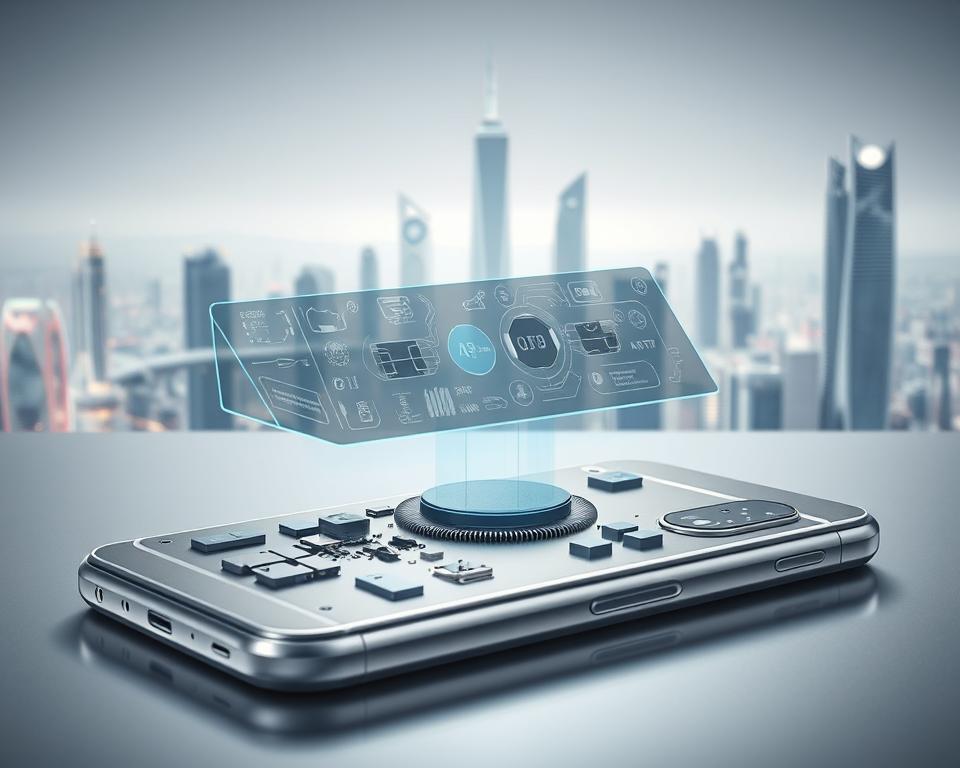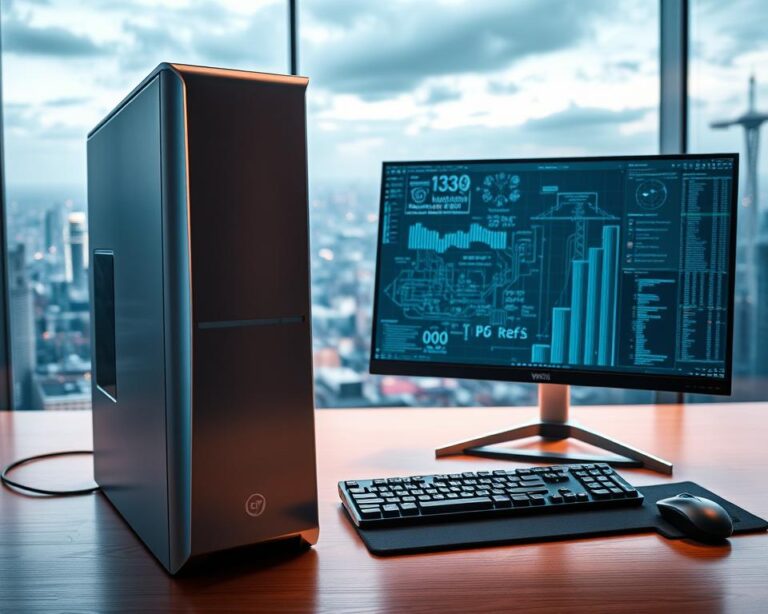
What Are the 5 Types of Mobile Technology?
Did you know that over 5 billion people around the globe own a mobile device? This staggering figure highlights the profound impact of mobile technology on our daily lives. As it continues to evolve, understanding what are the 5 types of mobile technology can help us navigate the ever-changing landscape of communication and connectivity.
Mobile technology refers to the various forms of communication and devices that allow users to stay connected and access information on the go. By exploring mobile technology types and their classification, you’ll gain insights into how these innovations have transformed not just how we communicate, but how we conduct business and interact socially.

Key Takeaways
- Over 5 billion mobile device users worldwide.
- Mobile technology consists of various forms of communication and devices.
- Understanding mobile technology classification enhances user awareness.
- Mobile technology shapes communication, business, and social interactions.
- Awareness of different mobile technology types can improve connectivity experiences.
Introduction to Mobile Technology
Mobile technology introduction represents a significant shift in the way we communicate and interact. Over the years, it has transformed from simple tools for voice calls to advanced devices that facilitate a myriad of functions. Today, mobile devices, such as smartphones and tablets, play a critical role in mobile communication, allowing users to connect effortlessly across the globe.
The rapid pace of technology advancements has brought forth innovations that enhance the convenience and accessibility of mobile devices. Many individuals rely on these devices for daily tasks, from messaging and emailing to video conferencing and accessing social media platforms. Businesses leverage mobile technology to reach their clients more effectively, highlighting the vital place mobile communication occupies in both personal and professional domains.

| Technology Milestones | Description | Impact on Communication |
|---|---|---|
| 1990s | Advent of mobile phones | Basic voice communication became possible anywhere. |
| 2000s | Introduction of smartphones | Integration of internet access and applications revolutionized communication. |
| 2010s | Rise of mobile apps | Apps facilitated instant messaging and social networking. |
| 2020s | 5G Technology | Enabled faster connections and more reliable communication services. |
Understanding Mobile Technology Types
Mobile technology encompasses a variety of devices and protocols facilitating wireless communication. This broad definition includes mobile phones, tablets, and various other gadgets that utilize both hardware and software to operate. The mobile technology definition involves not only the physical devices like smartphones but also the embedded software, including applications and operating systems that enable users to interact with the digital world.
Definition of Mobile Technology
The types of mobile technology can be categorized into several segments, including mobile communication technologies, mobile operating systems, and mobile applications. These components collectively help facilitate seamless connectivity and communication. Understanding mobile technology means acknowledging how these various elements come together to serve users’ needs effectively.
Importance of Mobile Technology
The importance of mobile technology in today’s society cannot be overstated. It has a profound impact on various sectors such as healthcare, education, and business. For instance, healthcare professionals utilize mobile devices to monitor patients in real-time, enhancing care quality. In education, students access learning materials via mobile applications, fostering an environment of flexibility and on-the-go learning. Businesses increasingly rely on mobile devices for communication and collaboration, which boosts productivity and connectivity among teams.

The overall impact of mobile devices on daily life is evident. With the rapid advancement of mobile technology, users gain unprecedented access to information and services directly from their pockets, reshaping how they interact with the world around them.
Smartphone Technology Types
Smartphones have become an integral part of modern living, driven by varying smartphone operating systems that significantly affect how users interact with their devices. Understanding the leading operating systems, along with the features and capabilities that differentiate the types of smartphones, is essential for making informed purchasing decisions. This section delves into the main operating systems and the remarkable features available in today’s smartphones.
Operating Systems in Smartphones
Smartphones primarily run on two dominant operating systems: Android and iOS. Each system offers unique advantages that cater to diverse user preferences:
| Operating System | User Interface | Customizability | Ecosystem Compatibility |
|---|---|---|---|
| Android | Flexible interface, various designs | Highly customizable with widgets and themes | Compatible with Google services and multiple manufacturers |
| iOS | Sleek, uniform interface | Limited customization options | Integrated with Apple ecosystem, including iCloud and Apple Music |
Features and Capabilities
Modern smartphones boast an impressive array of features and capabilities that enhance usability and performance. Notable aspects include:
- Camera technologies: Many devices now feature multiple lenses, offering options such as ultra-wide, telephoto, and macro photography.
- Processing power: Flagship models are equipped with advanced processors, ensuring speedy app performance and multitasking.
- Connectivity options: Smartphones support Bluetooth, Wi-Fi, and 5G cellular networks, allowing seamless connection to other devices and the internet.
- App ecosystems: Both Android and iOS provide extensive app stores, giving users access to a wide range of applications for various needs.

Different Types of Mobile Communication Technologies
Mobile communication technologies have revolutionized how we connect and communicate in today’s world. Understanding the different cellular network types and complementary technologies like Wi-Fi and Bluetooth can greatly enhance user experiences and device functionality.
Cellular Networks
Cellular network types play a crucial role in mobile communication technologies. The transition from 4G LTE to 5G offers significant improvements in data speed and network capacity. With 5G, users experience lower latency, allowing for smoother streaming and more responsive applications. This advancement supports the increasing demand for higher performance in various sectors, from entertainment to enterprise solutions.
Wi-Fi and Bluetooth Technologies
Beyond cellular networks, Wi-Fi technology and Bluetooth technology are essential for seamless connectivity. Wi-Fi provides internet access without the limitations of cellular data plans, making it convenient for home and public spaces. Bluetooth facilitates quick and easy device pairing for file transfers, audio streaming, and more. These mobile communication technologies create a robust ecosystem that enhances overall user experiences.

| Technology | Primary Use | Range | Data Speed |
|---|---|---|---|
| 4G LTE | Mobile Internet Access | Up to 10 km | 50 Mbps to 1 Gbps |
| 5G | Mobile Internet Access | Up to 1 km | 1 Gbps to 20 Gbps |
| Wi-Fi | Internet Connectivity | Up to 100 m | 50 Mbps to 10 Gbps |
| Bluetooth | Device Pairing | Up to 100 m | 1 Mbps to 3 Mbps |
The Role of Mobile Hardware
Understanding mobile hardware is essential for appreciating the diverse landscape of mobile technology. While many associate mobile devices primarily with smartphones, there exists a variety of types of mobile devices, each serving unique functionalities. This section will explore these device types and highlight the importance of mobile device components that contribute to their performance.
Types of Mobile Devices
Mobile devices encompass a range of gadgets beyond just smartphones. Here are some common types of mobile devices:
- Tablets: Larger screens suitable for media consumption and productivity, often running on operating systems like iOS or Android.
- Wearables: Devices like smartwatches that offer health tracking and notifications, integrating seamlessly with smartphones.
- Laptops: Portable computers providing advanced functionalities, often utilizing various hardware technology compared to smartphones.
- E-readers: Devices designed primarily for reading digital content, featuring specialized screens to reduce eye strain.
Mobile Device Components
The performance and user experience of these devices heavily depend on various mobile device components. Key components include:
| Component | Function |
|---|---|
| Processor | Acts as the brain of the device, executing commands and managing tasks. |
| Battery | Powers the device, affecting its portability and usage time. |
| Storage | Holds the operating system, applications, and user data, influencing overall performance. |
| Camera | Enables photography and video recording, contributing to the device’s versatility. |
| Sensors | Include functionalities like touch detection and motion sensing, enhancing interactivity. |
What Are the 5 Types of Mobile Technology?
Understanding what are the 5 types of mobile technology opens a window into the diverse applications and functionalities available today. Each category serves unique purposes to meet varying user needs and preferences. The primary types include:
- Smartphones: These devices combine advanced computing capabilities with mobile communication. They support a range of applications, offering extensive features such as high-resolution cameras, internet browsing, and social media connectivity.
- Feature Phones: While less complex than smartphones, feature phones cater to users seeking basic communication functionalities. They are often more affordable and last longer on a single charge, appealing to many users.
- Tablets: Larger than smartphones, tablets provide a bigger screen for content consumption and productivity tasks. Their diverse app ecosystem broadens their usability for entertainment, work, and educational purposes.
- Wearables: Devices like smartwatches and fitness trackers fall into this category. They focus on health monitoring and notifications, integrating seamlessly with smartphones to enhance user interaction.
- Mobile Internet Devices: These devices allow users to access the internet on the go, typically featuring built-in cellular capabilities or relying on Wi-Fi connections. They are essential for users who prioritize constant web access.
The mobile technology diversity in these types illustrates the vast options available to consumers, catering to various lifestyles and preferences. Each type plays a critical role in shaping how people connect, communicate, and engage with technology on a daily basis.
Mobile Technology Categories
Mobile technology encompasses a variety of categories that can be classified according to their specific functionalities and user demographics. Understanding these mobile technology categories allows for a better grasp of how different technologies serve distinct needs across various industries.
Classification Based on Functionality
Mobile technology can be classified based on its core technology functionality. This classification includes, but is not limited to, the following categories:
- Communication: Tools designed for messaging, voice calls, and video conferencing.
- Navigation: Apps and devices that provide location tracking and mapping services.
- Entertainment: Platforms for gaming, streaming videos, and audio consumption.
- Productivity: Software solutions that aid in task management, note-taking, and document editing.
Classification Based on Usage
Another perspective involves sorting mobile technology usage classifications based on user categories. This approach highlights how individuals and organizations utilize mobile technologies:
- Personal Use: Technologies designed for individual enjoyment, such as smartphones and tablets.
- Business Use: Devices and applications that facilitate corporate communication and workflow management.
- Educational Use: Tools that support learning experiences, including e-learning platforms and educational apps.
Emerging Technologies in Mobile
As mobile technology continues to evolve, emerging innovations are setting new standards across various industries. Two pivotal advancements, 5G technology and IoT mobile technology, play a significant role in shaping the future of connectivity and device capabilities.
5G Technology and Its Impact
The arrival of 5G technology signifies a substantial leap forward in mobile tech impact. With enhanced speed, lower latency, and improved connectivity, this technology promises to transform sectors like telemedicine and autonomous driving. The capabilities of 5G will allow for real-time data transmission, empowering smart devices to communicate seamlessly and facilitating innovative applications within urban infrastructure.
The Rise of IoT in Mobile Tech
The integration of IoT mobile technology is revolutionizing the interaction between everyday devices and users. With the Internet of Things impact growing, smart homes and wearable technology are more connected than ever. Devices can share data with each other, streamlining automation and providing enhanced user experiences. From controlling home appliances remotely to tracking health metrics in real time, the potential applications of IoT are vast, reflecting a significant shift in the role of mobile technology in modern life.
The Evolution of Mobile Technology
The evolution of mobile technology reflects a remarkable journey that began with basic communication tools and has transitioned into sophisticated mobile devices. The history of mobile technology is marked by significant advancements and milestones that illustrate how far we have come. This overview takes a closer look at the mobile devices timeline, highlighting key developments from early devices to the smartphones we use today.
History of Mobile Devices
Initially, mobile technology began with rotary dial phones which were reliant on extensive wiring and infrastructure. The invention of the first commercial mobile phone in 1983 marked a turning point, enabling communication on the go. As the years passed, technological improvements led to the introduction of more compact and efficient models, culminating in the early smartphones of the early 2000s. These devices set the foundation for the current mobile technology evolution, incorporating features like touchscreens, internet connectivity, and app ecosystems.
The Transition from 3G to 5G
The transition from 3G to 5G signifies a transformative leap in mobile technology capabilities. 3G networks provided significant improvements in data speed and facilities for mobile internet use. However, the rollout of 5G technology has transformed the landscape, offering speeds that are exponentially faster and reducing latency significantly, which enhances everything from streaming services to mobile gaming. The advancements not only focus on speed but also bolster overall connectivity, paving the way for innovative applications in areas like smart cities and the Internet of Things (IoT).
| Mobile Technology Era | Key Features | Impact |
|---|---|---|
| 1G | Analog Voice Calls | First generation of mobile phones, focused on voice communication. |
| 2G | Text Messaging, Digital Voice | Introduction of SMS and improved sound quality. |
| 3G | Mobile Broadband | Increased data transfer speeds, enabling mobile internet access. |
| 4G | High-Speed Internet, Streaming | Enhanced multimedia capabilities and high-definition content streaming. |
| 5G | Ultra-Fast Data Speeds, Low Latency | Enabled advanced technologies like IoT, smart cities, and autonomous vehicles. |
Challenges in Mobile Technology
As mobile technology continues to evolve, it brings with it a set of challenges that users and developers must navigate. These include mobile security concerns and mobile connectivity challenges, which can significantly affect user experiences and device functionality.
Security Concerns
Mobile security concerns revolve around various threats, including data breaches, hacking attempts, and the unauthorized access of sensitive information. As mobile devices store vast amounts of personal data, the risks associated with inadequate security measures are increasing. Implementing strong security protocols is essential to mitigate mobile technology risks and protect users from potential attacks.
Connectivity Issues
Another aspect of mobile technology challenges is connectivity. Many users experience poor signal strength and network issues, which can lead to frustrating mobile connectivity challenges. These issues can manifest as slow data speeds, dropped calls, and connectivity failures in apps. Such problems not only hinder communication but also affect access to essential services and information.
| Challenge Type | Description | Impact |
|---|---|---|
| Security Risks | Unauthorized access to personal data and devices. | Compromise of user privacy and financial loss. |
| Network Issues | Poor signal strength and network congestion. | Interruption in communication and reduced app performance. |
| Data Breaches | Exposure of sensitive information to cybercriminals. | Loss of trust in service providers and potential legal repercussions. |
| Signal Interference | External factors that disrupt connectivity. | Inconsistent user experience and reliance on backup solutions. |
Benefits of Understanding Mobile Technology Classifications
Understanding mobile technology classifications offers significant advantages, both for consumers and developers. Grasping the different types of mobile technologies leads to informed choices and enhanced usability for everyone involved in the mobile ecosystem.
For Consumers
The benefits of mobile technology understanding are crucial for consumers navigating the vast landscape of mobile devices. Familiarity with various classifications allows consumers to harness valuable consumer insights, empowering them to select devices that align with their specific needs and lifestyles. With knowledge of hardware capabilities, operating systems, and app ecosystems, individuals can make more educated purchasing decisions, ensuring satisfaction with their mobile technology choices.
For Developers
Mobile technology understanding for developers significantly impacts application design and performance. By comprehending the various types of mobile devices and their functionalities, developers can tailor applications to meet specific user needs effectively. These developer benefits include the creation of intuitive interfaces and optimized user experiences, which ultimately lead to higher user engagement and satisfaction. Well-informed developers can anticipate challenges and design solutions that cater to diverse mobile environments.
| Category | Consumer Insights | Developer Benefits |
|---|---|---|
| Device Knowledge | Choose devices that fit lifestyle | Create optimized applications |
| Operating Systems | Understand app compatibility | Develop multi-platform solutions |
| User Experience | Enhance satisfaction | Improve app performance |
| Market Trends | Stay ahead in technology | Innovate with new features |
Comparison of Mobile Technology Varieties
As the landscape of mobile technology evolves, understanding various mobile operating systems becomes essential. A thorough comparison of mobile operating systems allows users to identify the best fit for their needs. This mobile OS analysis examines strengths, weaknesses, and unique functionalities of each system to guide informed decisions.
Analyzing Different Mobile Operating Systems
When evaluating popular mobile operating systems like Android and iOS, several factors come into play:
- Customization: Android offers extensive customization options, allowing users to personalize their experience, while iOS focuses on simplicity and uniformity.
- App Ecosystem: Both platforms boast a vibrant ecosystem, although iOS may offer higher-quality applications due to strict developer guidelines.
- Updates: Apple devices receive regular updates directly from the company, ensuring enhanced security and features, while Android’s update frequency may vary across manufacturers.
Feature Comparison Across Devices
Device feature comparison reveals which mobile technology features excel in specific areas such as photography, gaming, and battery life. The following table highlights key specifications of notable devices:
| Device Model | Operating System | Camera Quality | Battery Life | Storage Options |
|---|---|---|---|---|
| iPhone 14 Pro | iOS | 48 MP Triple Camera | Up to 29 hours talk time | 128GB, 256GB, 512GB, 1TB |
| Samsung Galaxy S23 Ultra | Android | 200 MP Quad Camera | Up to 34 hours talk time | 256GB, 512GB, 1TB |
| Google Pixel 7 Pro | Android | 50 MP Triple Camera | Up to 24 hours talk time | 128GB, 256GB |
By analyzing these varied characteristics, readers can gain valuable insights when choosing their next mobile device tailored to personal preferences or specific requirements.
Future Trends in Mobile Technology
As the landscape of mobile technology continuously evolves, innovation predictions become increasingly fascinating. Future mobile technology trends indicate advancements in several areas, shaping how individuals interact with devices and each other. This section delves into anticipated innovations, highlighting their potential effects on daily life and changing lifestyles.
Predicted Innovations
The integration of artificial intelligence will enhance user experiences, making devices smarter and more responsive. Features like context-aware applications will adapt seamlessly to individual habits and preferences. Augmented reality will redefine engagement, offering immersive experiences in education, entertainment, and commerce. Furthermore, breakthroughs in battery technology promise prolonged usage times, significantly enhancing device performance and user satisfaction.
Impact on Daily Life
The impact of mobile technology on daily life will be profound. Enhanced connectivity will streamline daily tasks, from shopping to communication. The convenience brought by these technologies will facilitate smoother, more efficient interactions. Future lifestyle changes will reflect a shift toward reliance on mobile solutions, transforming the way people manage their time and resources.
| Innovation | Key Feature | Impact on Daily Life |
|---|---|---|
| Artificial Intelligence | Context-aware applications | Personalized experiences |
| Augmented Reality | Immersive engagement | Enhanced education and shopping |
| Battery Technology | Long-lasting power | Improved device reliability |
Conclusion
In summary, the exploration of mobile technology reveals its multifaceted nature and significant influence on our daily lives. This conclusion on mobile technology emphasizes the critical understanding of the five distinct types, which include smartphones, communication technologies, mobile hardware, and emerging trends. Each aspect contributes uniquely to shaping how consumers and businesses interact in an increasingly connected world.
Recognizing the various classifications enables both consumers and developers to make informed choices and adapt to ongoing advancements. As the landscape continues to evolve, staying updated on the summary of mobile technology types will prove invaluable for leveraging opportunities in this dynamic field.
Ultimately, the journey through mobile technology is far from over. Encouraging exploration and awareness will not only enhance personal engagement with these tools but also drive innovation across industries, paving the way for a more connected future.



